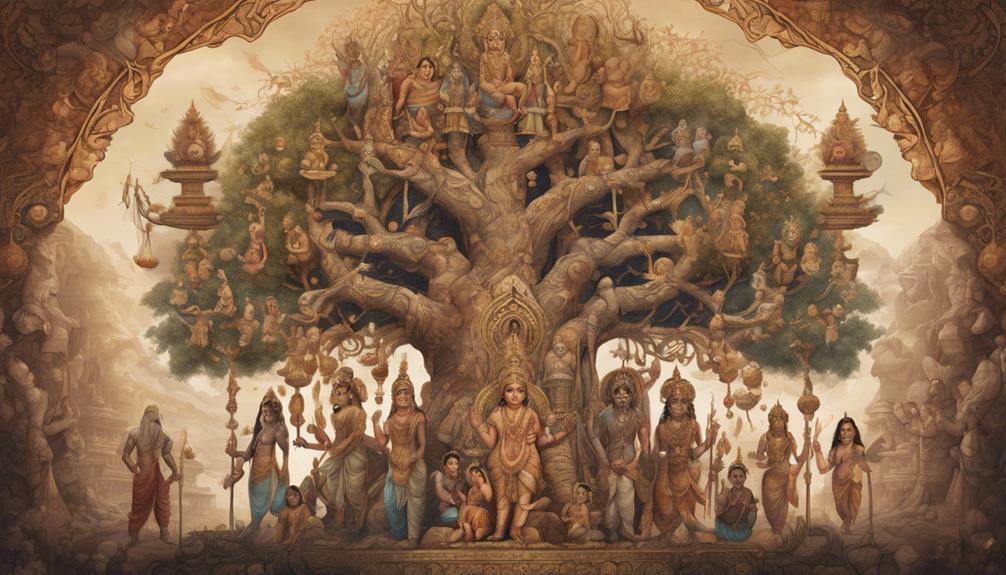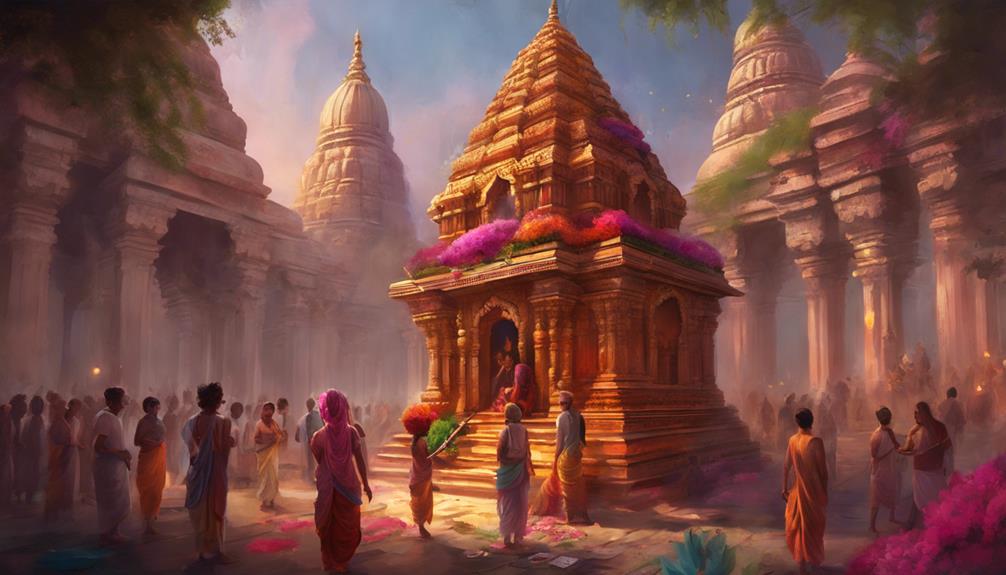The Puranas intricately reveal the complexities of Hindu deities by delving into their character, symbolism, divine lineages, and cosmic roles. By exploring these facets, you gain a deeper understanding beyond mere folklore, discovering profound insights into the rich spirituality of Hinduism. The Puranic texts elevate your comprehension of the multifaceted nature of these divine beings, offering a gateway to a world of intricate symbolism, familial dynamics, and cosmic significance that shape the very fabric of existence.
Gain a new perspective on the depths of Hindu deities' roles and significance in the cosmos, expanding your knowledge and appreciation of their cultural and mythological importance.
Table of Contents
Key Takeaways
- Puranas reveal deep-rooted beliefs and traditions about Hindu deities.
- Symbolism in Puranic texts enhances understanding of deity attributes.
- Divine lineages in Puranas highlight interconnected familial relationships among deities.
- Deities in Puranas shape Hindu cosmology, reflecting the interconnectedness of existence.
- Rituals and worship practices influenced by Puranas offer insights into deity roles and devotion.
Mythological Tales and Deity Descriptions
Exploring the intricate mythological tales and vivid deity descriptions** found in the Puranas provides invaluable insights into the multifaceted world of Hindu deities. These texts offer more than mere stories; they serve as windows into the symbolic interpretations and storytelling techniques** that shape the Hindu understanding of gods and goddesses.
The Puranic texts aren't just repositories of folklore origins but are rich in cultural significance. Through the narratives contained within them, one can uncover the deep-rooted beliefs and traditions that have been passed down through generations. The Puranas not only recount the deeds and adventures of deities but also delve into the moral and ethical teachings they embody.
Comparing the deity descriptions across different Puranas reveals the nuances in character traits and attributes assigned to each god or goddess. The storytelling techniques employed vary, showcasing the diverse ways in which these divine beings are portrayed and revered. By analyzing these intricacies, one can gain a deeper understanding of the complexities within Hindu mythology and the significance of deity descriptions in shaping religious beliefs.
Symbolism and Iconography in Puranic Texts
Symbolism and iconography in Puranic texts intricately depict the divine attributes and representations of Hindu deities, offering profound insights into the religious symbolism of these revered figures. The symbolic representations found in the Puranas serve as a visual language that conveys complex philosophical concepts and narratives associated with each deity. Through artistic expressions such as intricate hand gestures (mudras), ornaments, weapons, and mounts, each deity's unique characteristics and attributes are symbolically represented, aiding devotees in understanding their significance.
Furthermore, the iconography of deities across different Puranic texts often reveals variations that highlight regional, cultural, and mythological differences. For example, while the depiction of Lord Vishnu in the Vishnu Purana emphasizes his role as a preserver through symbols like the conch shell and discus, the portrayal of Lord Shiva in the Shiva Purana focuses on his attributes as a destroyer through symbols like the trident and third eye. These variations in artistic representations provide a rich tapestry of symbolism that enhances the devotee's understanding of the multifaceted nature of Hindu deities.
Divine Lineages and Family Dynamics

The intricate symbolism and iconography in Puranic texts not only depict the divine attributes of Hindu deities but also shed light on the fascinating dynamics of divine lineages and family relationships within the pantheon. Genealogical significance plays a vital role in understanding the hierarchy and interconnectedness among deities. By tracing the ancestry of gods and goddesses, one can unravel the generational dynamics that shape their roles and interactions within the divine family structure.
Ancestral connections are highlighted to emphasize the continuity of power and responsibility passed down through generations. These connections reveal how divine family relationships influence the functions and myths associated with specific deities. For instance, the lineage of Lord Shiva through Brahma and Vishnu showcases a complex web of relationships that illustrate the cyclical nature of creation, preservation, and destruction in Hindu cosmology. Understanding these divine lineages not only enriches the narrative depth of the Puranas but also provides insights into the intricate familial bonds that define the roles and responsibilities of Hindu deities.
The Role of Deities in Hindu Cosmology
Within Hindu cosmology, deities play integral roles in shaping the fabric of existence through their dynamic interactions and cosmic functions. These divine beings aren't just symbols or mythological figures but are believed to be active participants in the ongoing creation, preservation, and dissolution of the universe.
Each deity represents different aspects of the cosmos and embodies specific qualities that hold spiritual significance for followers. For example, Brahma is the creator deity responsible for the birth of all beings, Vishnu is the preserver who maintains cosmic order, and Shiva is the destroyer who paves the way for new beginnings. The cosmic manifestations of these deities are intertwined in a complex web of relationships, reflecting the interconnectedness of all existence.
Understanding the roles of these deities in Hindu cosmology provides insights into the cyclical nature of creation and the eternal dance of life, death, and rebirth.
Rituals and Worship Practices

Deities in Hindu cosmology influence the intricate rituals and worship practices observed by followers, shaping the spiritual landscape through their dynamic roles in the cosmic order. The Puranas provide detailed insights into the sacred offerings made to various deities, emphasizing the significance of rituals in establishing a connection between worshippers and the divine. Additionally, meditation techniques prescribed in the Puranic texts offer devotees a means to deepen their spiritual practice and cultivate a profound communion with the gods.
Moreover, temple architecture plays a crucial role in Hindu worship practices, with temples serving as physical embodiments of cosmic principles and divine presence. The Puranas often describe the construction and consecration of temples dedicated to specific deities, highlighting the importance of these sacred spaces in fostering devotion and facilitating communal worship. Additionally, festival celebrations, as outlined in the Puranic narratives, provide devotees with opportunities to express their reverence through elaborate rituals, processions, and collective acts of worship, reinforcing the bond between humans and the divine.
Frequently Asked Questions
How Do the Puranas Influence Modern Hindu Religious Practices and Beliefs?
In modern Hindu religious practices and beliefs, the Puranas play a pivotal role by influencing ritual practices through mythological narratives. They provide a rich tapestry of stories and traditions that shape worship and understanding of deities.
Are There Any Controversies or Debates Surrounding the Interpretations of Puranic Texts and Their Portrayal of Deities?
When exploring Puranic texts, you'll encounter interpretation debates and controversial portrayals of deities. Scholars and followers often clash over varying understandings, leading to ongoing discussions on the significance and implications of these differing viewpoints.
What Role Do Lesser-Known Deities Play in the Puranic Texts and How Are They Perceived in Hinduism?
In Hinduism, lesser-known deities hold significance in puranic texts. They add richness to the vast pantheon, embodying various aspects of life and nature. Perceptions of these deities reflect the diversity and inclusivity of Hindu beliefs.
How Do the Puranas Address the Concept of Gender and Sexuality in Relation to Hindu Deities?
When exploring gender roles and divine love in Hinduism, the Puranas provide a rich tapestry of narratives that explore into the complexities of sexual symbolism. These sacred texts offer insights into the fluidity of gender and the diverse expressions of love among deities.
What Are the Different Regional Variations and Interpretations of Puranic Stories and Deities Across India?
Explore the rich tapestry of Hindu mythology across India. Regional variations offer diverse interpretations of Puranic stories and deities. Each locale infuses its unique cultural nuances, giving depth and breadth to the understanding of these ancient tales.
Conclusion
Ultimately, the Puranas provide a rich tapestry of mythological tales, deity descriptions, symbolism, and divine lineages that deepen our understanding of Hindu deities.
Through these texts, we gain insights into the roles, relationships, and significance of the gods and goddesses in Hindu cosmology.
The rituals and worship practices outlined in the Puranas further illuminate the importance of these deities in the lives of believers, showcasing the enduring impact of these ancient texts on Hindu spirituality.